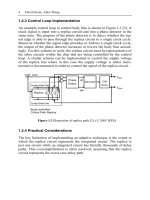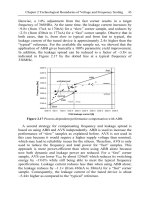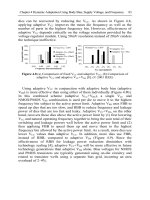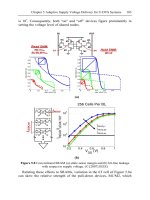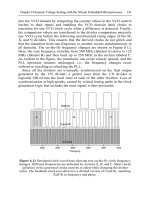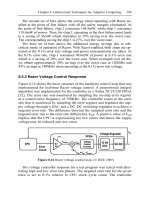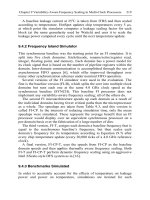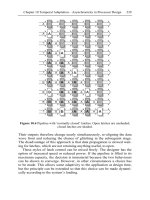Adaptive Techniques for Dynamic Processor Optimization_Theory and Practice Episode 1 Part 1 docx
Bạn đang xem bản rút gọn của tài liệu. Xem và tải ngay bản đầy đủ của tài liệu tại đây (602.63 KB, 20 trang )
Adaptive Techniques for Dynamic
Processor Optimization
Theory and Practice
Series on Integrated Circuits and Systems
Series Editor: Anantha Chandrakasan
Massachusetts Institute of Technology
Cambridge, Massachusetts
Adaptive Techniques for Dynamic Processor Optimization: Theory and Practice
Alice Wang and Samuel Naffziger (Eds.)
ISBN 978-0-387-76471-9
mm-Wave Silicon Technology: 60 GHz and Beyond
Ali M. Niknejad and Hossein Hashemi (Eds.)
ISBN 978-0-387-76558-7
Ultra Wideband: Circuits, Transceivers, and Systems
Ranjit Gharpurey and Peter Kinget (Eds.)
ISBN 978-0-387-37238-9
Creating Assertion-Based IP
Harry D. Foster and Adam C. Krolnik
ISBN 978-0-387-36641-8
Design for Manufacturability and Statistical Design: A Constructive Approach
Michael Orshansky, Sani R. Nassif, and Duane Boning
ISBN 978-0-387-30928-6
Low Power Methodology Manual: For System-on-Chip Design
Michael Keating, David Flynn, Rob Aitken, Alan Gibbons, and Kaijian Shi
ISBN 978-0-387-71818-7
Modern Circuit Placement: Best Practices and Results
Gi-Joon Nam and Jason Cong
ISBN 978-0-387-36837-5
CMOS Biotechnology
Hakho Lee, Donhee Ham and Robert M. Westervelt
ISBN 978-0-387-36836-8
SAT-Based Scalable Formal Verification Solutions
Malay Ganai and Aarti Gupta
ISBN 978-0-387-69166-4, 2007
Ultra-Low Voltage Nano-Scale Memories
Kiyoo Itoh, Masashi Horiguchi and Hitoshi Tanaka
ISBN 978-0-387-33398-4, 2007
Routing Congestion in VLSI Circuits: Estimation and Optimization
Prashant Saxena, Rupesh S. Shelar, Sachin Sapatnekar
ISBN 978-0-387-30037-5, 2007
Ultra-Low Power Wireless Technologies for Sensor Networks
Brian Otis and Jan Rabaey
ISBN 978-0-387-30930-9, 2007
Sub-Threshold Design for Ultra Low-Power Systems
Alice Wang, Benton H. Calhoun and Anantha Chandrakasan
ISBN 978-0-387-33515-5, 2006
High Performance Energy Efficient Microprocessor Design
Vojin Oklibdzija and Ram Krishnamurthy (Eds.)
ISBN 978-0-387-28594-8, 2006
Continued after index
Alice Wang • Samuel Naffziger
Editors
Adaptive Techniques
for Dynamic Processor
Optimization
Theory and Practice
123
ISBN: 978-0-387-76471-9 e-ISBN: 978-0-387-76472-6
DOI: 10.1007/978-0-387-76472-6
Library of Congress Control Number: 2007943527
© 2008 Springer Science+Business Media, LLC
All rights reserved. This work may not be translated or copied in whole or in part without the written
permission of the publisher (Springer Science+Business Media, LLC, 233 Spring Street, New York,
NY 10013, USA), except for brief excerpts in connection with reviews or scholarly analysis. Use in
connection with any form of information storage and retrieval, electronic adaptation, computer
software, or by similar or dissimilar methodology now known or hereafter developed is forbidden.
The use in this publication of trade names, trademarks, service marks and similar terms, even if they
are not identified as such, is not to be taken as an expression of opinion as to whether or not they are
subject to proprietary rights.
While the advice and information in this book are believed to be true and accurate at the date of going
to press, neither the authors nor the editors nor the publisher can accept any legal responsibility for any
errors or omissions that may be made. The publisher makes no warranty, express or implied, with
respect to the material contained herein.
Printed on acid-free paper
9 8 7 6 5 4 3 2 1
springer.com
Editors
Alice Wang Samuel Naffziger
Texas Instruments, Inc. Advanced Micro Devices
Dallas, TX Fort Collins, CO
USA USA
Series Editor
Anantha Chandrakasan
Department of Electrical Engineering
and Computer Science
Massachusetts Institute of Technology
Cambridge, MA 02139
USA
Preface
The integrated circuit has evolved tremendously in recent years as Moore’s
Law has enabled exponentially more devices and functionality to be
packed onto a single piece of silicon. In some ways however, these highly
integrated circuits, of which microprocessors are the flagship example,
have become victims of their own success. Despite dramatic reductions in
the switching energy of the transistors, these reductions have kept pace
neither with the increased integration levels nor with the higher switching
frequencies. In addition, the atomic dimensions being utilized by these
highly integrated processors have given rise to much higher levels of
random and systematic variation which undercut the gains from process
scaling that would otherwise be realized. So these factors—the increasing
impact of variation and the struggle to control power consumption—have
given rise to a tremendous amount of innovation in the area of adaptive
techniques for dynamic processor optimization.
The fundamental premise behind adaptive processor design is the
recognition that variations in manufacturing and environment cause a
statically configured operating point to be far too inefficient. Inefficient
designs waste power and performance and will quickly be surpassed by
more adaptive designs, just as it happens in the biological realm.
Organisms must adapt to survive, and a similar trend is seen with
processors – those that are enabled to adapt to their environment, will be
far more competitive. The adaptive processor needs to be made aware of
its environment and operating conditions through the use of various
sensors. It must then have some ability to usefully respond to the sensor
stimulus. The focus of this book is not so much on a static configuration of
each manufactured part that may be unique, but on dynamic adaptation,
where the part optimizes itself on the fly.
Many different responses and adaptive approaches have been explored
in recent years. These range from circuits that make voltage changes and
set body biases to those that generate clock frequency adjustments on
logic. New circuit techniques are needed to address the special challenges
created by scaling embedded memories. Finally, system level techniques
rely on self-correction in the processor logic or asynchronous techniques
which remove the reliance on clocks. Each approach has unique challenges
vi Preface
and benefits, and it adds value in particular situations, but regardless of the
method, the challenge of reliably testing these adaptive approaches looms
as one of the largest. Hence the subtitle the book: Theory and Practice.
Ideas (not necessarily good ones) on adaptive designs are easy to come by,
but putting these in working silicon that demonstrates the benefits is much
harder. The final level of achievement is actually productizing the
capability in a high-volume manufacturing flow.
In order for the book to do justice to such a broad and relatively new
topic, we invited authors who have already been pioneers in this area to
present data on the approaches they have explored. Many of the authors
presented at ISSCC2007, either in the Microprocessor Forum, or in the
conference sessions. We are humbled to have collected contributions from
such an impressive group of experts on the subject, many of whom have
been pioneers in the field and produced results that will be impacting the
processor design world for years to come. We believe this topic of
adaptive design will continue to be a fertile area for research and
integrated circuit improvements for the foreseeable future.
Alice Wang Texas Instruments, Inc.
Samuel Naffziger Advanced Micro Devices, Inc.
Table of Contents
Chapter 1 Technology Challenges Motivating Adaptive Techniques 1
David Scott, Alice Wang
1.1 Introduction 1
1.2 Motivation for Adaptive Techniques 2
1.2.1 Components of Power 2
1.2.2 Relation Between Frequency and Voltage 2
1.2.3 Control Loop Implementation. 4
1.2.4 Practical Considerations 4
1.2.5 Impact of Temperature and Supply Voltage Variations 7
1.3 Technology Issues Relating to Performance-
Enhancing Techniques 9
1.3.1 Threshold Voltage Variation 9
1.3.2 Random Dopant Fluctuations 11
1.3.3 Design in the Presence of Threshold Voltage Variation 13
1.4 Technology Issues Associated with Leakage
Reduction Techniques 14
1.4.1 Practical Considerations 15
1.4.2 Sources of Leakage Current 16
1.4.3 Transistor Design for Low Leakage 20
1.5 Conclusion 21
References 21
Chapter 2 Technological Boundaries of Voltage and Frequency
Scaling for Power Performance Tuning 25
Maurice Meijer, José Pineda de Gyvez
2.1 Adaptive Power Performance Tuning of ICs 25
2.2 AVS- and ABB-Scaling Operations 28
2.3 Frequency Scaling and Tuning 31
2.4 Power and Frequency Tuning 33
2.5 Leakage Power Control 37
2.6 Performance Compensation 40
2.7 Conclusion 44
References 46
viii Table of Contents
Chapter 3 Adaptive Circuit Technique for Managing
Power Consumption 49
Tadahiro Kuroda, Takayasu Sakurai
3.1 Introduction 49
3.2 Adaptive V
DD
Control 50
3.2.1 Dynamic Voltage Scaling 50
3.2.2 Frequency and Voltage Hopping 51
3.3 Adaptive V
TH
Control 55
3.3.1 Reverse Body Bias (VTCMOS) 55
3.3.1.2 Leakage Current Monitor 56
3.3.1.3 V
TH
Controllability 57
3.3.1.4 Device Perspective 59
3.3.2 Forward Body Bias 60
3.3.3 Control Method and Granularity 61
3.3.4 V
TH
Control Under Variations 64
3.3.5 V
TH
Control vs. V
DD
Control 66
3.4 Hardware and Software Cooperative Control 68
3.4.1 Cooperation Between Hardware and Application Software 68
3.4.2 Cooperation Between Hardware and Operating System 70
3.5 Conclusion 71
References 71
Chapter 4 Dynamic Adaptation Using Body Bias,
Supply Voltage, and Frequency 75
James Tschanz
4.1 Introduction 75
4.2 Static Compensation with Body Bias and Supply Voltage 76
4.2.1 Adaptive Body Bias 77
4.2.2 Adaptive Supply Voltage 82
4.3 Dynamic Variation Compensation 84
4.3.1 Dynamic Body Bias 84
4.3.2 Dynamic Supply Voltage, Body Bias, and Frequency 87
4.3.2.1 Design Details 87
4.3.2.2 Measurement Results 89
4.4 Conclusion 92
References 92
Chapter 5 Adaptive Supply Voltage Delivery
for Ultra-Dynamic Voltage Scaled Systems 95
Yogesh K. Ramadass, Joyce Kwong, Naveen Verma, Anantha Chandrakasan
5.1 Logic Design for U-DVS Systems 97
3.3.1.1 Self-Adjusting Threshold Voltage (SAT) Scheme 55
Table of Contents ix
5.1.1 Device Sizing 98
5.1.2 Timing Analysis 100
5.2 SRAM Design for Ultra Scalable Supply Voltages 101
5.2.1 Low-Voltage Bit-Cell Design 104
5.2.2 Periphery Design 105
5.3 Intelligent Power Delivery 107
5.3.1 Deriving V
DD
for Given Speed Requirement 107
5.3.2 DC-DC Converter Topologies for U-DVS 109
5.3.2.1 Linear Regulators 109
5.3.2.2 Inductor Based DC-DC Converter 109
5.3.2.3 Switched Capacitor Based DC-DC Converter 110
5.3.3 DC-DC Converter Design and Reference Voltage
Selection for Highly Energy-Constrained Applications 112
5.3.3.1 Minimum Energy Tracking Loop 113
5.4 Conclusion 119
References 120
Chapter 6 Dynamic Voltage Scaling with the XScale
Embedded Microprocessor 123
Lawrence T. Clark, Franco Ricci, William E. Brown
6.1 The XScale Microprocessor 123
6.1.1 Chapter Overview 124
6.1.2 XScale Micro-Architecture Overview 125
6.1.3 Dynamic Voltage Scaling 126
6.1.4 The Performance Measurement Unit 127
6.2 Dynamic Voltage Scaling on the XScale Microprocessor 129
6.2.1 Running DVS 130
6.3 Impact of DVS on Memory Blocks 134
6.3.1 Guaranteeing SRAM Stability with DVS 134
6.4 PLL and Clock Generation Considerations 138
6.4.1 Clock Generation for DVS on the 180 nm
80200 XScale Microprocessor 138
6.4.2 Clock Generation 90 nm XScale Microprocessor 139
6.5 Conclusion 142
References 142
Chapter 7 Sensors for Critical Path Monitoring 145
Alan Drake
7.1 Variability and its Impact on Timing 145
7.2 What Is a Critical Path 147
7.3 Sources of Path Delay Variability 148
7.3.1 Process Variation 149
x Table of Contents
7.3.2 Environmental Variation 149
7.4 Timing Sensitivity of Path Delay 151
7.5 Critical Path Monitors 158
7.5.1 Synchronizer 158
7.5.2 Delay Path Configuration 159
7.5.3 Time-to-Digital Conversion 163
7.5.3.1 Sensitivity 167
7.5.4 Control and Calibration 168
7.6 Conclusion 169
Acknowledgements 171
References 171
Chapter 8 Architectural Techniques for Adaptive Computing 175
Shidhartha Das, David Roberts, David Blaauw, David Bull, Trevor Mudge
8.1 Introduction 175
8.1.1 Spatial Reach 177
8.1.2 Temporal Rate of Change 177
8.2 “Always Correct” Techniques 179
8.2.1 Look-up Table-Based Approach 179
8.2.2 Canary Circuits-Based Approach 180
8.2.3 In situ Triple-Latch Monitor 181
8.2.4 Micro-architectural Techniques 182
8.3 Error Detection and Correction Approaches 183
8.3.1 Techniques for Communication and Signal Processing 184
8.3.2 Techniques for General-Purpose Computing 186
8.4 Introduction to Razor 187
8.4.1 Razor Error Detection and Recovery Scheme 188
8.4.2 Micro-architectural Recovery 190
8.4.2.1 Recovery Using Clock-Gating 190
8.4.2.2 Recovery Using Counter-Flow Pipelining 191
8.4.3 Short-Path Constraints 192
8.4.4 Circuit-Level Implementation Issues 192
8.5 Silicon Implementation and Evaluation of Razor 195
8.5.1 Measurement Results 196
8.5.2 Total Energy Savings with Razor 197
8.5.3 Razor Voltage Control Response 199
8.7 Conclusion 202
References 203
8.6 Ongoing Razor Research 200
Table of Contents xi
Chapter 9 Variability-Aware Frequency Scaling
in Multi-Clock Processors 207
Sebastian Herbert, Diana Marculescu
9.1 Introduction 207
9.2 Addressing Process Variability 209
9.2.1 Approach 209
9.2.2 Combinational Logic Variability Modeling 212
9.2.3 Array Structure Variability Modeling 213
9.2.4 Application to the Frequency Island Processor 215
9.3 Addressing Thermal Variability 217
9.4 Experimental Setup 218
9.4.1 Baseline Simulator 218
9.4.2 Frequency Island Simulator 219
9.4.3 Benchmarks Simulated 219
9.5 Results 220
9.5.1 Frequency Island Baseline 220
9.5.2 Frequency Island with Critical Path Information 221
9.5.3 Frequency Island with Thermally Aware
Frequency Scaling 222
9.5.4 Frequency Island with Critical Path Information
and Thermally Aware Frequency Scaling 224
9.6 Conclusion 224
Acknowledgements 225
References 225
Chapter 10 Temporal Adaptation – Asynchronicity
in Processor Design 229
Steve Furber, Jim Garside
10.1 Introduction 229
10.2 Asynchronous Design Styles 230
10.3 Asynchronous Adaptation to Workload 232
10.4 Data Dependent Timing 234
10.5 Architectural Variation in Asynchronous Systems 237
10.5.1 Adapting the Latch Style 237
10.5.2 Controlling the Pipeline Occupancy 240
10.5.3 Reconfiguring the Microarchitecture 241
10.6 Benefits of Asynchronous Design 244
10.7 Conclusion 245
References 245
xii Table of Contents
Chapter 11 Dynamic and Adaptive Techniques in SRAM Design 249
John J. Wuu
11.1 Introduction 249
11.2 Read and Write Margins 250
11.2.1 Voltage Optimization Techniques 251
11.2.1.1 Column Voltage Optimization 252
11.2.1.2 Row Voltage Optimization 255
11.2.2 Timing Control 257
11.3 Array Power Reduction 259
11.3.1 Sleep Types 259
11.3.1.1 Active Sleep 260
11.3.1.2 Passive Sleep 261
11.3.2 P Versus N Sleep 263
11.3.3 Entering and Exiting Sleep 264
11.3.4 Dynamic Cache Power Down 266
11.3.5 Data Bus Encoding 266
11.4 Reliability 267
11.4.1 Soft Errors 267
11.4.2 Hard Errors 267
11.4.2.1 Cache Line Disable 268
11.4.2.2 Cache Line Remap 268
11.4.2.3 Defect Correction 268
11.5 Conclusion 269
References 270
Chapter 12 The Challenges of Testing Adaptive Designs 273
Eric Fetzer, Jason Stinson, Brian Cherkauer, Steve Poehlman
12.1 The Adaptive Features of the Itanium 2 9000 Series 273
12.1.1 Active De-skew 273
12.1.2 Cache Safe Technology 277
12.1.3 Foxton Technology 278
12.2 The Path to Production 281
12.2.1 Fundamentals of Testing with Automated Test
Equipment (ATE) 281
12.2.2 Manufacturing Test 281
12.2.3 Class or Package Testing 283
12.2.4 System Testing 285
12.3 The Impact of Adaptive Techniques on Determinism
and Repeatability 286
12.3.1 Validation of Active De-skew 287
12.3.2 Testing of Active De-skew 290
12.3.3 Testing of Power Measurement 291
Table of Contents xiii
12.3.4 Power Measurement Impacts on Other Testing 294
12.3.5 Test Limitations and Guard-Banding 296
12.4 Guard-Band Concerns of Adaptive Power Management 297
12.5 Conclusion 300
References 300
Index 303
List of Contributors
Alan Drake IBM
Alice Wang
Anantha Chandrakasan
Texas Instruments
Massachusetts Institute of Technology
Brian Cherkauer Intel Corporation
David Blaauw University of Michigan
David Bull ARM Ltd.
David Roberts University of Michigan
David Scott Taiwan Semiconductor Manufacturing
Company Ltd.
Diana Marculescu Carnegie Mellon University
Eric Fetzer Intel Corporation
Franco Ricci Marvell Semiconductor Inc.
James Tschanz Intel Corporation
Jason Stinson Intel Corporation
Jim Garside The University of Manchester
John J. Wuu Advanced Micro Devices, Inc.
José Pineda de Gyvez NXP Semiconductors,
Eindhoven University of Technology
Joyce Kwong Massachusetts Institute of Technology
Lawrence T. Clark Arizona State University
Naveen Verma Massachusetts Institute of Technology
Sebastian Herbert Carnegie Mellon University
Shidhartha Das ARM Ltd.,
University of Michigan
Steve Furber The University of Manchester
Steve Poehlman Intel Corporation
Tadahiro Kuroda Keio University
Takayasu Sakurai University of Tokyo
Trevor Mudge University of Michigan
William E. Brown Ellutions, LLC
Yogesh K. Ramadass Massachusetts Institute of Technology
xvi List of Contributors
Maurice Meijer NXP Semiconductors
Chapter 1 Technology Challenges Motivating
Adaptive Techniques
David Scott,
1
Alice Wang
2
1.1 Introduction
In the design of an integrated circuit, the designer is faced with the chal-
lenge of having circuits and systems function over multiple operating
points. From the point of view of performance, the circuit must meet its
speed requirements over a range of voltages and temperatures that reflect
the environment that the circuit is operating in. Also while the perform-
ance requirement must be met at a set of worst-case conditions for speed,
the power requirement must be simultaneously met at another set of worst-
case conditions for power.
Although each design is unique, the resulting instances of fabricated in-
tegrated circuits will number potentially in the billions. In addition, the
number of components for each of the integrated circuits will also poten-
tially number in the billions. Every single one of the billions of transistors
in every one of the billions of circuits is unique. The success of an inte-
grated circuit design is simply measured by the percentage of the fabri-
cated integrated circuits with the transistors, as well as interconnections,
meeting all the requirements.
The use of adaptive techniques allows for an integrated circuit to adapt for
variations in the environment as reflected by both voltage and temperature
and also for variations in the fabricated transistors. Adaptive techniques are
intended to allow minimization of both dynamic and leakage power and also
to increase the frequency of operation of the integrated circuit.
1
Taiwan Semiconductor Manufacturing Company Ltd.,
2
Texas
Instruments, Inc.
A. Wang, S. Naffziger (eds.), Adaptive Techniques for Dynamic Processor Optimization,
DOI: 10.1007/978-0-387-76472-6_1, © Springer Science+Business Media, LLC 2008
2 David Scott, Alice Wang
1.2 Motivation for Adaptive Techniques
1.2.1 Components of Power
The total power dissipation of an integrated circuit can be simply repre-
sented by the power equation below. The power is divided into three major
components: the dynamic component, the subthreshold leakage compo-
nent, and the parasitic leakage components. The dynamic component de-
pends on the overall capacitance of the integrated circuit and the charge
that must be displaced for each clock cycle. This is the power that is actu-
ally doing work to implement the function of the integrated circuit. Tech-
niques such as clock gating [1] reduce power by gating the clock in unused
parts of the integrated circuit, thereby reducing the effective capacitance of
the integrated circuit:
2
0 th tox gedl
P CV f V N (I exp(-nV /(kT/q)) I I )=+ ++
(1.1)
The subthreshold leakage current is simply tied to the threshold voltage
of the transistors in the integrated circuit. As the threshold voltage (V
th
) in-
creases, the subthreshold current decreases exponentially. However, while
significant leakage savings can be achieved by increasing the threshold
voltage, a high threshold voltage tends to force designers to operate the
circuits at higher voltages in order to achieve the performance goals. Gate
oxide leakage (I
tox
) and gate edge diode leakage (I
gedl
) relate to the charac-
teristics of both the gate oxide and the silicon. These parasitic components
of leakage will be discussed in a later section.
1.2.2 Relation Between Frequency and Voltage
As shown in Figure 1.1, operating frequency increases as the supply volt-
age of the integrated circuit increases [2]. Note that the straight line in this
plot does not extrapolate back to zero but rather a larger value that depends
on the threshold voltage of the transistors in the circuit. Hence, at a given
supply voltage, the frequency of the integrated circuit can be changed by
changing the threshold voltage. Threshold voltage can be controlled dy-
namically by changing the transistor body bias. Hence, supply voltage and
body bias provide two degrees of freedom over which to control both fre-
quency and power.
Chapter 1 Technology Challenges Motivating Adaptive Techniques 3
Figure 1.1 Frequency versus voltage [2]. (© 2005 IEEE)
A conceptual plot for the case where the frequency is constrained to be a
constant is shown in Figure 1.2. This illustrates the tradeoffs that can be
made between the choice of supply voltage and threshold voltage. If the
transistors have a low threshold voltage, the leakage power is very high
and the dynamic power is quite low. That is because the operating fre-
quency can be achieved at a relatively lower supply voltage and yet the
low threshold voltage results in a high leakage current. As the threshold
voltage is increased, the supply voltage to maintain the operating fre-
quency is also increased and hence dynamic power increases. At the same
time, the increasing threshold voltage results in a lower leakage power. For
a given integrated circuit, there is an optimum point where the power is
minimized. This is the point where the increase in dynamic power is offset
by the decrease in leakage power.
Figure 1.2 As VDD is increased, the body bias is adjusted to keep operating
frequency constant [3]. (© 2002 IEEE)
4 David Scott, Alice Wang
1.2.3 Control Loop Implementation
An example control loop to control body bias is shown in Figure 1.3 [3]. A
clock signal is input into a replica circuit and into a phase detector at the
same time. The purpose of the phase detector is to detect whether the sig-
nal edge is able to pass through the replica circuit in a single clock cycle.
Based on whether the signal edge precedes or follows a single clock cycle,
the output of the phase detector increases or lowers the body bias accord-
ingly. For this scheme to work, the replica circuit must be representative of
the other circuits within the chip that are being controlled by the control
loop. A similar scheme can be implemented to control the supply voltage
of the replica line where in this case the supply voltage is either incre-
mented or decremented in order to control the speed of the replica circuit.
Figure 1.3 Illustration of replica path [3]. (© 2005 IEEE)
1.2.4 Practical Considerations
The key limitation of implementing an adaptive technique is the extent to
which the replica circuit represents the integrated circuit. The replica is
just one circuit while an integrated circuit has literally thousands of delay
paths. This oversimplification is often resolved, assuming that the replica
circuit represents the worst-case delay path.
